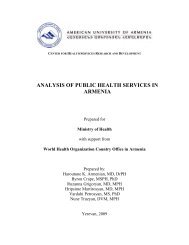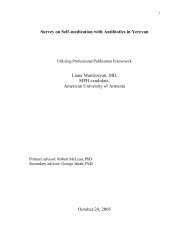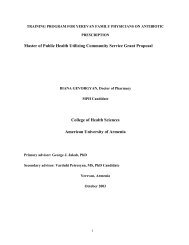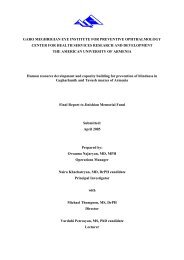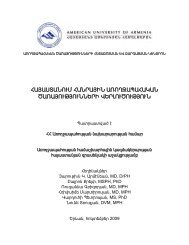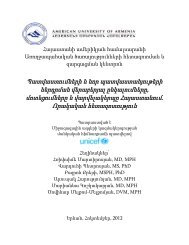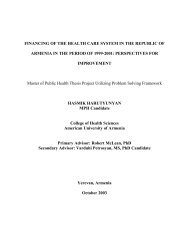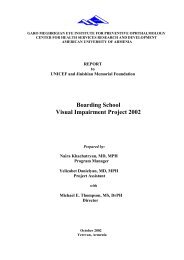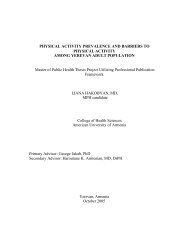A M E R I C A N U N I V E R S I T Y O F A R M E N I A - CHSR
A M E R I C A N U N I V E R S I T Y O F A R M E N I A - CHSR
A M E R I C A N U N I V E R S I T Y O F A R M E N I A - CHSR
You also want an ePaper? Increase the reach of your titles
YUMPU automatically turns print PDFs into web optimized ePapers that Google loves.
circumference, which is used for estimating acute malnutrition in emergency cases were<br />
considered inappropriate. Another parameter - weight-for-height (WH) is an indicator that relates<br />
body mass to stature (wasting). Height-for-age (HA) is a measure of linear growth and<br />
considered as an indicator of past nutritional adequacy. Any deficit of this indicator is the sign of<br />
stunting [25]. As a cut-off level ±2 Z-scores of WA, WH, and HA were considered abnormal.<br />
Another method of nutritional assessment is determining the hemoglobin (Hb) concentration<br />
or hematocrit (Hct), where for children aged 2-5 and 5-8 years old anemia is defined as an<br />
hemoglobin concentration < 11.2 g/dl (hematocrit < 34%) and 11.5 g/dl (hematocrit 34.5%)<br />
respectively [29, 30]. However, the effectiveness of screening on anemia will be lowered if the<br />
cut-off level is not adjusted for high and mid altitudes, mentioned in many studies [29] (Table 4).<br />
Therefore, during analysis of this study the cut-off level was defined as 11.4g/dl (11.2 + 0.2) for<br />
children aged 2-5, 11.7 g/dl (11.5 + 0.2) for children aged 5-8, and 12.1 g/dl (11.9 + 0.2) for<br />
children after 8 (Table 3). [31, 32, 33]. These cut-off levels were defined due to adaptive<br />
responses of hematological parameters to high and mid altitude environment and the elevated<br />
hemoglobin concentration in high and low altitude is explained by systolic pulmonary arterial<br />
pressure (Ppa) difference [32].<br />
Data collection and management<br />
Collected data was paper-based information with different types of variable measurement.<br />
The data were coded and data screen was formatted, using SPSS-11 software package. In order<br />
to eliminate the errors cleaning and double entry with checking were performed, regrouping and<br />
recoding were used for analyzing the data [22]. The data, used for assessment of nutritional<br />
status were transferred and analyzed in EpiInfo2000. Main statistical methods, used to analyze<br />
the data were variance ratio, two-sample t-test with equal variances, Pearson chi-square, and<br />
18




